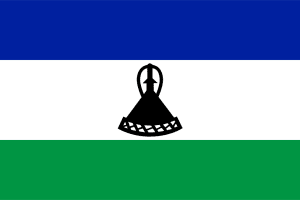
| Colors | HEX Code | RGB | CMYK |
|---|---|---|---|
| Blue | #00209F | 0, 32, 159 | 100, 80, 0, 38 |
| White | #FFFFFF | 255, 255, 255 | 0, 0, 0, 0 |
| Green | #009543 | 0, 149, 67 | 100, 0, 55, 42 |
| Black | #000000 | 0, 0, 0 | 0, 0, 0, 100 |
The flag of Lesotho has three unequal horizontal stripes. The top stripe is colored blue, the middle stripe is colored white, and the bottom stripe is colored green. In the middle of the flag, there is a black emblem that features a black Basotho hat at its center, or a “Mokorotlo.”
Meaning of Lesotho’s Flag
The blue color at the top of Lesotho’s flag symbolizes the sky and rain. The white color in the middle represents peace and people’s aspirations for unity. The green color signifies the prosperity and richness of the land. The black symbol represents a traditional hat called Mokorotlo. It stands for the indigenous Basotho people and their cultural legacy.
History of Lesotho’s Flag
Lesotho was a group of local tribes. Its name was Basutoland. A treaty signed with Britain in 1843 turned Lesotho into a British protectorate. On October 4th, 1966, the colony of Basutoland became an independent nation. The flag that was adopted on independence had green and red vertical stripes at the hoist, with a blue field and a white Basotho hat. In 1987, a military coup overthrew the government and the flag was changed. the stripes were made diagonal, ordered white, blue, and green, and the emblem changed into a brown shield and traditional weapons. In 2006, Lesotho celebrated 40 years of independence, and a new flag was hoisted. The flag is still used today to represent Lesotho, its people, and its culture.